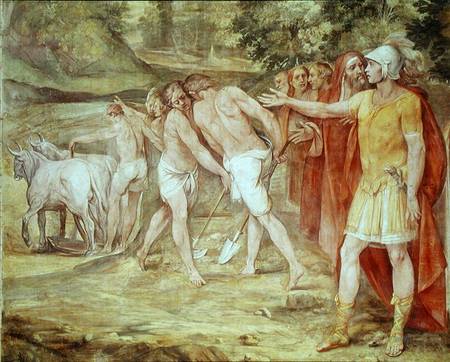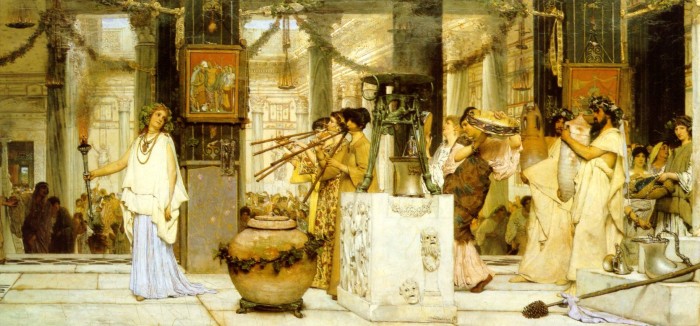Civitas and urbs, which we render as city, were not synonymous among the ancients. The civitas was the religious and political association of the families of a tribe; the urbs was the place of reunion, the domicile, and, above all, the sanctuary of this association….
Once the families, the phratries, and the tribes agreed to unite and have the same cult, they founded a city to be the sanctuary for the common cult. Thus the founding of a city was always a religious act.
We shall take Rome itself for our first example.
When the founding day arrived, first he [Romulus] offered a sacrifice. His companions gathered around him; they lit a brushwood fire, and each jumped over the thin flame. The explanation of this rite is that for the act about to take place it was necessary that the people be pure; in other words, the ancients believed they purified themselves of all physical or moral blemish by jumping over the sacred flame.

Romulus marking the limits of Rome, from the Sala dei Horatii e Curatii (fresco) by Cesari, Guiseppe (1568-1640)
When this preliminary ceremony had prepared the people for the great act of founding, Romulus dug a little ditch in the shape of a circle. Into it he threw a little heap of earth he had brought from the town of Alba. Then each of his companions approached in turn, throwing in a little piece of earth he had brought from whence he had come. This ritual is remarkable, and it reveals a consideration among these men which it is important to point out. Before coming to the Palatine, they lived in Alba or the neighboring towns. That was their home; that was where their fathers had lived and were buried. In other words, the religion prohibited them from leaving the land where the home had been fixed and where the divine ancestors lay. It was then necessary, to rid themselves of any impiety, that each man employ a fiction, bringing with him, symbolized by a clump of earth, the sacred earth where his ancestors were buried and to which their manes were attached. Man could not move without bringing his land and his ancestors with him. It was necessary for this rite to be accomplished for him to be able to say, in indicating the new place he had adopted: This is still the land of my fathers, terra partum, patria; this is my fatherland, for here lie my family’s manes. (Foustel de Coulanges, La Cité Antique, book 2, pp. 151-154 passim).
Plinio Corrêa de Oliveira, Nobility and Analogous Traditional Elites in the Allocutions of Pius XII: A Theme Illuminating American Social History (York, Penn.: The American Society for the Defense of Tradition, Family, and Property, 1993), Documents VII, pp. 499-500.










